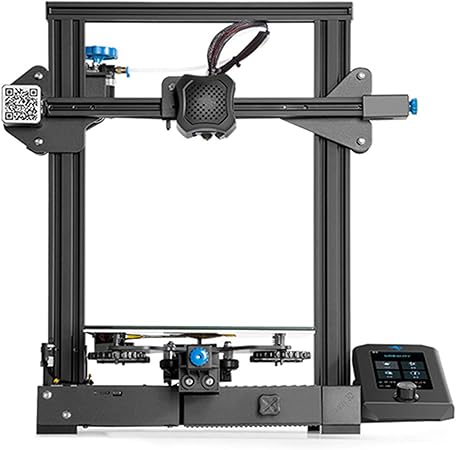Page Contents
Details: NaoSIn-Ni Ender-3 V2 3D Printer, FDM DIY Printer Works Resume Printing Function High Precision Printing Support PLA/TPU/PETG Print Size 220 * 220 * 250Mm
Brand: NaoSIn-Ni
Product Description:Do you want to try a 3D printer?Do you want to try to “move” the laboratory to your home?Our printer is simple to assemble, the system should be intuitive and easy to operate, extruder, hot bed, cable, all of which can be redefined.Please choose our 3D printer, it will satisfy you.Features:Classic and stable appearanceIntegrated structure designHigh-precision printingCarbon crystal silicon glass platformRapid heating in 5 minuteseasy to useResume after power failureHumanized designNew displayParameter:Product size: 475*470*620mmPrinting layer thickness: 0.1-0.4mmPrinting size: 220*220*250mmPrinting consumables: PLA/TPU/PETGMolding technology: FDMComputer operating system: MAC/WindowsXP/7/8/10Slicing software: Simplifysd/curaPrinting accuracy: ±0.1mmHot bed temperature: ≤100°Consumable diameter: 1.75mmOur product quality is guaranteed, please rest assured to buy.
Advantages
- Products can be returned
- Make sure this fits by entering your model number.
- [Large Build Volume]Large build volume 220*220*250mm help you achieve your different printing ideas, enrich your printing life, you can try more and bigger print models.
- [Rapid Heating Bed]The carbon crystal silicon glass plate provides a strong adhesion, so the printing model will not easily become warped, so users can realize quick manual mold taking.
- [High-standard V-groove Profile]The V-groove profile and pulley ensures stable and stable printing operation, also can reduce the noise during printing.
- [Resume Printing & Convenient Filament Feed-in]The machine can automatically resume printing after power-off or filament breakage, less worries on print failure, rotary knob added on the extruder makes it easier to load and feed filament.
Notice
- Is an online purchase
- Delivery may be delayed in some areas.
Buyer Guide 3D Printers
A 3D printer is a machine that allows you to create three-dimensional objects from a digital file or from a 3D model.- Price. The price ranges from $300 for an entry-level printer to $5,000 for an industrial printer.
- Print Speed. The print speed is the amount of time it takes to print a 3D object. The print speed varies with the printer model, but the average is 0.2 to 0.4 seconds per layer.
- Resolution. The resolution is the number of points per inch (PPI). The higher the resolution, the more detailed the 3D object will be. The higher the resolution, the more detailed the 3D object will be.
- Nozzle size. The nozzle size indicates the size of the nozzle used. The nozzle size on entry-level printers is 0.4 mm and goes to 0.3 mm on professional printers.
- Materials. There are many types of 3D prints. The most common is PLA, which is approved by the ABS standards.
- Filament. The filament is the material that goes into the nozzle of the printer. The filament comes in various colors and is typically sold in 1.75-gallon spools.
How to choose 3D Printers
When shopping for a 3D printer, there are a couple of key factors to keep in mind:- How easy is the 3D printer to use? Buying a 3D printer can be intimidating, particularly if you’re not familiar with how it works. When choosing a printer, look for one that has a clear instruction manual, as well as clear and detailed guides online. Also, consider whether the 3D printer comes with software or is compatible with other platforms.
- Does the 3D printer work right? 3D printers aren’t cheap. Before you buy a 3D printer, it’s important to test it out and make sure it works right. Most 3D printers come with either an SD card or a USB flash drive, so it’s a good idea to download and test the 3D printer’s software before committing to the purchase.
How to maintain 3D Printers
3D printing is a remarkable way to create complex, functional objects. However, 3D printing is also incredibly time-consuming, complicated, and expensive.Because of this, many 3D printers require regular maintenance. For instance, most 3D printers have a nozzle, which can get clogged with debris over time.
These clogs can slow down your prints, cause jams and errors, and ruin the quality of your 3D creations.
There are countless tutorials and guides on how to unclog a 3D printer’s nozzle. However, many of these guides require expensive replacement parts or professional equipment.
Luckily, there are several ways to clean your 3D printer’s nozzle without purchasing expensive replacement parts. Some of the most common ways to clean a 3D printer’s nozzle are:
- Cleaning the nozzle with alcohol.
- Cleaning the nozzle with dish soap.
- Installing a UV lamp.
- Cleaning the nozzle with a toothbrush.
- Using a rotating brush.
- Using compressed air to blow away debris.




